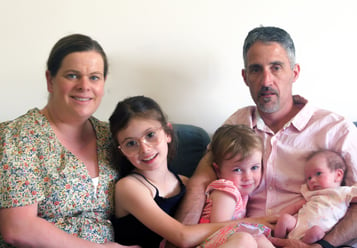Our Cherry Blossom: When the cherries just take a little longer to grow
we share our personal journey with our youngest daughter, Averley, who was born small and diagnosed with a rare growth disorder. From navigating her early struggles with feeding and weight gain, to the challenges of "failure to thrive" and the emotional impact of hearing those words, this story offers support and hope to families facing similar experiences. We also discuss the transition to tube feeding and the ongoing search for answers, aiming to provide encouragement to others walking a similar path.
Hayley Laney
5/8/20244 min read
“Everything blooms in its own time.” – Ken Petti
When Averley entered our world, she was a tiny 2.4kg, with a head full of hair and as cute as a button. She was much smaller than expected, even compared to her sisters, who were also small babies.
Born via C-section, she spent her first 24 hours in the humidicrib in the nursery, while I was wheeled back and forth to feed her. She took to breastfeeding fairly well, but we topped up with small amounts of expressed breast milk, which my husband would finger feed. She was progressing, and mostly regained the weight expected after birth. The paediatrician hesitantly let us go home after five days, with a follow-up appointment for the next week.
Once home, we immediately had to isolate, as our middle daughter and her grandparents had caught COVID. Isolating Averley from the rest of the family was tough, but thankfully, she didn’t fall ill. This just added to the challenges of those early days. At her first check-up, the paediatrician noted that her weight was not tracking along a normal growth curve, despite her feeding well. This marked the start of our journey of “thriving slowly”—a term our paediatrician often used and became a source of light-heartedness in our discussions about her growth.
Feeding Plans
Having successfully breastfed my older children until they were 12 and 13 months, I never doubted Averley was getting enough. She seemed content, with normal urine and stool output. However, she did have recurring urinary tract infections (UTIs), which raised concerns.
Our first step was to assess if supply and demand were being met by breastfeeding alone. For a week, we trialled expressing and bottle-feeding, fortifying her feeds with formula. While supplementation is sometimes seen as negative, the “feed and grow” approach is often the first solution tested. So, we went with it. Each day, we reported to the doctor the amounts I expressed and Averley consumed, then provided a weekly summary. It was exhausting! To any mums who exclusively express, you are incredible—pumping, measuring, cleaning, sterilising—it’s a monumental task. The result: she grew, but not enough. She was feeding well but not gaining as expected. Next step: a renal ultrasound.
Tests and Outcomes
We embarked on a series of tests to understand why Averley was so low on the growth charts. First, a renal ultrasound, followed by extensive bloodwork, including thyroid function tests. The results showed a Vitamin D deficiency and yet another UTI, leading to a course of antibiotics and Vitamin D supplements. We continued breastfeeding and offering top-up bottles at night, though she rarely took them, always seeming full. By now, Averley had become a “snacker.” Interestingly, despite being surrounded by the activity of our bustling household, she rarely napped during the day. However, from about eight weeks old, she was sleeping through the night—something I now see may have been an early indicator of other issues.
When these tests didn’t reveal any major concerns, we continued focusing on the “feed and grow” strategy. We started solids early, hoping to boost her calorie intake. Although she wasn’t quite ready at four months, by five months, she was eager to eat and quickly became my best eater by far! She loved her food. But despite eating like a horse, her growth barely moved the needle, remaining below the third percentile—until it stopped altogether.
At her regular CAFHS (Community and Family Health Service) check-up, I was shocked to learn she hadn’t gained any weight in three months. Back to the paediatrician we went, but this time, things were different. The usual approach wasn’t working. It was time for a new plan.
A New Feeding Plan
By this point, she was still breastfeeding, eating solids, and no longer taking supplementary bottles. The next concern was a possible milk protein allergy, which is different from lactose intolerance but can commonly hinder growth in babies. I had to switch to a dairy- and soy-free diet—no more cheese or chocolate! She was also prescribed a specialised formula, which she refused. When this plan also failed, it became clear that something deeper was going on.
Averley started getting sick more often—frequent colds, flus, and fevers. While she met most of her developmental milestones, she had low muscle tone, looked pale, and developed ongoing eczema. We suspected coeliac disease, especially given her reactions to oats, but further tests ruled it out. Despite all this, she continued to thrive in spirit, even though her body wasn’t quite catching up. It was at this point that I heard the words every parent dreads: “Failure to thrive.”
Failure to Thrive
Hearing the term “failure to thrive” brings up a flood of emotions. While I never felt like I had failed her, I know many parents struggle with this label. I did everything I could to nourish my baby, but my instincts kept telling me that something was off. It was a difficult emotional journey. Though I didn’t experience the guilt others may feel, the uncertainty of her future weighed heavily on me.
Many well-meaning people told me she’d grow at her own pace, that “everyone blooms in their own time.” But while I appreciated their kindness, these comments felt dismissive of our search for answers. It’s true that not all babies fit neatly onto growth charts, but when growth stalls entirely, it’s a sign that something isn’t right. We now know that our little cherry blossom will flourish in her own way, but at the time, the uncertainty was hard to navigate.
And so, our journey into tube feeding and searching for a diagnosis truly began




